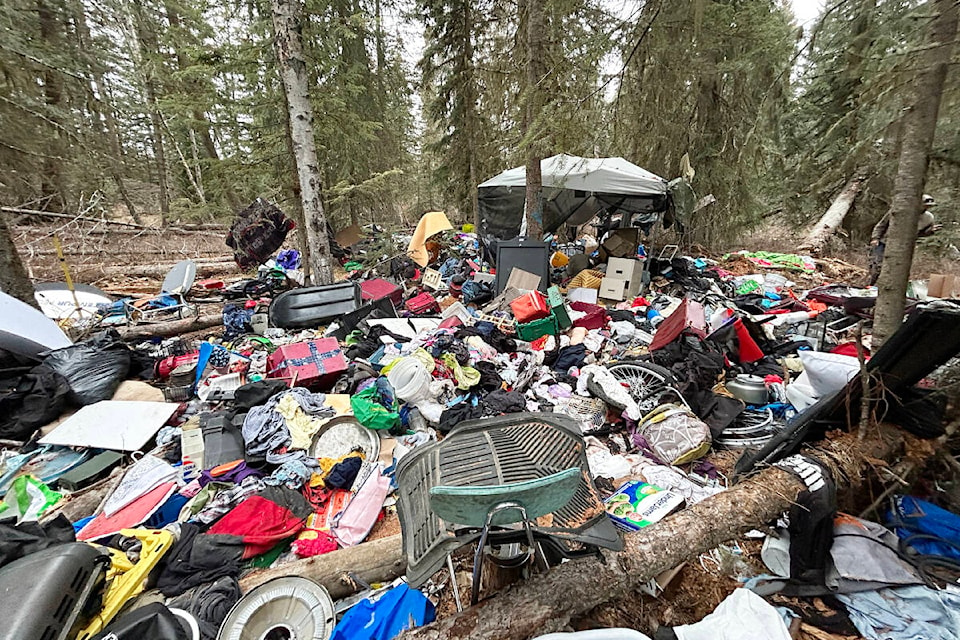If you go out in the woods today, and see a pile of illegally dumped items, who you gonna call?
The Thompson-Nicola Regional District (TNRD), that’s who. The TNRD operates a backcountry clean-up program, that can go in and clear up illegal dumping sites on Crown land. The program receives from 10 to 30 reports of illegal or abandoned dump or waste sites each year, and in 2023 cleaned up 14 sites containing approximately 32 tonnes of material.
The largest single clean-up was off the Timber Lake FSR near Lac Le Jeune, south of Kamloops. That one site contained about 8.5 tonnes of waste which had been dumped illegally.
Any illegal dump site should be reported says Adriana Mailloux, the TNRD’s manager of solid waste and recycling, as they can act like magnets, attracting more and more rubbish.
“Something starts as a little pile of yard waste and seems harmless, but turns into more. Even the smallest sites should be cleaned up, as they tend to grow over time.”
The TNRD has an online form at https://ow.ly/mf5950RnCAB where people can provide details of illegal dumping sites. Mailloux adds that people should also contact the Conservation Officer Service’s (COS) RAPP (Report All Poachers and Polluters) line at 1-877-952-7277 or #7277 on a cellphone.
“We encourage people to call the RAPP line, as the Conservation Officer Service is responsible for enforcement. They will look to see if they can find identifying information to see who’s responsible; once they’ve exhausted any leads the TNRD can commence clean-up.”
This only applies to Crown land, however. “The CO Service will investigate dumping on private property,” says Mailloux. “People sometimes operate illegal landfills on their property, which you can’t do.” Sanctions can range from being asked to clean it up to being fined.
Mailloux notes that when the TNRD goes in to an illegal dumping site, they often find that a lot of the items that have been loaded into a vehicle and then dumped in the backcountry could have been loaded into a vehicle and dropped off for free at most TNRD-operated Eco-Depots and Transfer Stations.
“We often find stuff that can be recycled for free, like scrap metal, yard waste, and tires. It’s very common to see large appliances like washers, stoves, dryers, fridges, and freezers, which are free to bring in to all of our larger sites. There might be more limited drop-off capacity at some of our smaller Transfer Stations.”
She adds that the fee for taking non-recyclable items, like household garbage, to a proper waste disposal site is not high. “Eco-depots go by weight, so it varies depending on what’s in there. An average load is around $20. Bagged garbage is $1 per bag to a maximum of four bags; any more than that and we switch to weight-based. Tthe minimum charge is just $4.50.”
Mailloux says that the TNRD uses a contractor, A and L Septic, to clean up sites once they have been identified.
“They will go in and complete a clean-up. In the case of the Timber Lake FSR they had to take in equipment; then they deactivated the site by placing logs across the road and putting up signage to prevent further dumping.”
She adds that public safety is the number one concern when it comes to dealing with reports of illegal dumping sites.
“We’re looking at what’s a risk to people. Is it a high-use area? Could it put someone at risk if they’re recreating in the area? If it’s something really old and out of the way, and has been there a long time, it might not be as much of a priority.
“We also look at environmental risk, and accessibility: how easy is it to get to, and is it going to get bigger? We also look at the size of the site.”
The TNRD has a new internal tracking system to manage reported sites, and Mailloux expects that the data will get better and better going forward. She says that the system allows people to upload photos of any site they find.
“Pictures are amazing and very, very helpful. If you have GPS coordinates you can enter them, but you also have the ability to pinpoint the location of the dump site and give directions, and there’s an area on the form for a description of what sort of material is there. It all goes into the reporting tool, and a staff person follows up.”
To find the location of the closest Eco-Depot or Transfer Station, and see what they accept, go to https://ow.ly/yOsO50RnCAA.
